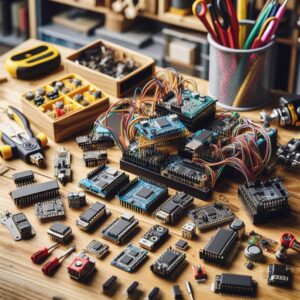Microcontrollers are the heart of any robotics project, acting as the brain that processes inputs and controls outputs. Whether you’re a beginner or an experienced maker, choosing the right microcontroller can make or break your DIY robotics project. In this guide, we’ll explore the best microcontrollers for robotics enthusiasts, highlighting their features, benefits, and ideal use cases.

1. Arduino Uno: The Beginner’s Favorite
The Arduino Uno is a classic choice for DIY robotics projects, especially for beginners. Its simplicity, affordability, and extensive community support make it a go-to option.
Key Features:
- Processor: ATmega328P (8-bit).
- I/O Pins: 14 digital and 6 analog.
- Programming: Easy-to-use Arduino IDE.
- Community: Tons of tutorials and libraries available.
Best For:
- Line-following robots.
- Obstacle-avoiding bots.
- Simple automation projects.
2. Raspberry Pi Pico: Compact and Powerful
The Raspberry Pi Pico is a microcontroller that combines affordability with impressive performance. It’s perfect for projects requiring more processing power than traditional microcontrollers.
Key Features:
- Processor: Dual-core ARM Cortex-M0+.
- I/O Pins: 26 GPIO pins.
- Connectivity: Supports USB for programming and communication.
- Cost: Budget-friendly.
Best For:
- Intermediate robotics projects.
- Projects requiring real-time data processing.
3. ESP32: The IoT Champion
The ESP32 is a versatile microcontroller with built-in Wi-Fi and Bluetooth, making it ideal for IoT-enabled robotics projects.
Key Features:
- Processor: Dual-core Xtensa LX6.
- Connectivity: Wi-Fi and Bluetooth.
- Power Efficiency: Low-power modes for battery-operated robots.
- Community: Strong support and resources.
Best For:
- Remote-controlled robots.
- IoT-enabled bots.
- Smart home automation projects.
4. STM32 Series: Professional-Grade Performance
The STM32 series offers high-performance microcontrollers suitable for advanced robotics projects. These microcontrollers are widely used in industrial applications.
Key Features:
- Processor: ARM Cortex-M cores.
- I/O Pins: Varies by model, offering extensive options.
- Real-Time Processing: Ideal for time-sensitive tasks.
- Development Tools: Supported by STM32Cube software.
Best For:
- Industrial-grade robots.
- Complex sensor integration.
- High-precision motor control.
5. Teensy 4.1: Small but Mighty
The Teensy 4.1 is known for its compact size and powerful processing capabilities, making it a favorite among robotics enthusiasts.
Key Features:
- Processor: ARM Cortex-M7 (600 MHz).
- I/O Pins: 55 digital and 18 analog.
- Performance: Handles complex algorithms with ease.
- Compatibility: Works with Arduino IDE.
Best For:
- High-speed robotics projects.
- Advanced AI and machine learning applications.
Conclusion: Choosing the Right Microcontroller
The best microcontroller for your DIY robotics project depends on your specific needs, budget, and experience level. Whether you’re building a simple line-following robot or a complex IoT-enabled bot, there’s a microcontroller out there for you.
- Beginners: Start with Arduino Uno for its simplicity and community support.
- Intermediate Makers: Explore Raspberry Pi Pico or ESP32 for more advanced features.
- Advanced Users: Dive into STM32 or Teensy 4.1 for professional-grade performance.
By selecting the right microcontroller, you’ll set your robotics project up for success and unlock endless possibilities for innovation.
